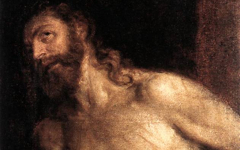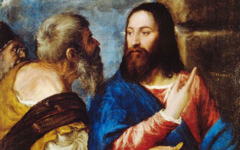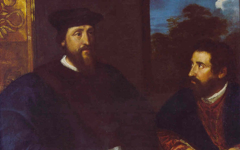Van Dyck’s Titian and His Mistress (1630’s)
An engraving known as Titian and His Mistress is normally attributed to Van Dyck and is said to be based on a lost self-portrait by Titian. Harold Wethey, a Titian specialist, argued that the original must have been "a pastiche or an outright forgery of about 1600, which Van Dyck mistook for an original by Titian. The composition is badly mis-scaled, and the whole idea of the lecherous old man and a stout young woman betrays no connection with Titian’s mentality. It is, moreover, open to question whether the unsigned etching is properly attributed to Van Dyck himself.”1 It is hazardous to argue against Wethey on an attribution to Titian, less so with Van Dyck. Nevertheless the evidence he used, an issue of morality and a discrepancy in scale, should alert the viewer to a problem in perception.
The woman is certainly out-of-scale with the diminutive Titian. The artist's hand flat on her costume resembles the gesture in Rembrandt's Self-Portrait with Saskia. There the artist's open hand touching his wife represents the artist painting his wife: the artist is "real", his wife painted. Scale was also an issue in Manet's Le Déjeuner sur l'Herbe. There his extra-large bather is also "a painting" which is why Manet originally called the whole composition, The Bath. The same interpretation helps explain both of Wethey's problems. All three paintings have each been accused of lax morals because viewers using normal perception have mis-understood the scene.
Click next thumbnail to continue
Besides, as we have shown elsewhere Titian himself had used an extra-large woman in a series of paintings of a nude Venus, in each of which the woman is larger than the male musician. This discrepancy in scale means, as in the Rembrandt, that the man is an "artist" creating his "work of art". Music, as a metaphor for the creation of art, has been a common theme in painting in every century since the Renaissance.2
Click next thumbnail to continue
Instead of music, though, Titian (or possibly Van Dyck) constructed a composition in which touch becomes the metaphor for "painting." Titian is said to have actually painted with his fingers in nearly every period of his career, beginning with the great Assunta in Venice, a painting we have already shown is based on touch as a metaphor for paint.3
Click next thumbnail to continue

Far left: Detail of Titian in Van Dyck's Titian and His Mistress
Near left, from top left corner clockwise: Titian, Georges d'Armagnac and His Secretary (detail); Titian, Pietà (detail of self-portrait, inverted); Titian, Noli Me Tangere (detail of self-portrait inverted); Titian, The Tribute Money (detail of the pharisee)
Click image to enlarge.
Even the pose of Titian's head, looking upwards (far left), can be linked to the heads of other disguised "artists" in Titian's oeuvre including his own self-portrait in the painting intended for his tomb (near upper right). They all look up towards their "work of art" at a similar angle.
Click next thumbnail to continue
I believe that the engraving is based on a drawing by Van Dyck. The style, and focus on touch, suggest it. However we cannot know whether Van Dyck copied a lost painting by Titian in which the Venetian artist was once seen adoring the great Mona Lisa of his own mind. He may have taken two independent figures by Titian (one a lost self-portrait) and combined them into a composition of his own making. Nevertheless the composition is still strikingly reminiscent of Titian's own esoteric constructions.
See conclusion below
In either case this engraving is a good example of how artists like Titian and Van Dyck used a variety of hand gestures to signify an "artist painting", sometimes with the hand placed obviously against a flat surface, sometimes with a finger pointing to the work of art and sometimes with a partly-open palm facing it. A discrepancy in size between two figures is also a common sign that we are looking at a "painting" within a painting. This occurs in both Titian's and Van Dyck's oeuvres and in that of many other great masters too. To become more familiar with such examples, try exploring the theme, Pointing and Touch, and for examples of "artists" next to their work of art seemingly out-of-scale, see Artist with His Art.
Notes:
1. Harold Wethey, Titian, vol. II, The Portraits, (Phaidon) 1971, pp. 181-2, cited by William Kloss on The Open Museum website: http://www.openmuseum.org/objet/show/528?facet=1090
2. Numerous artists have portrayed themselves, other artists or accepted alter egos as a performer with a musical instrument. The artists so depicted include Titian, Veronese, Paul Brill, Lavinia Fontana, Manet and Matisse.
3. Rona Goffen, Titian’s Women (Yale University Press) 1997, p. 213
Original Publication Date on EPPH: 30 Jun 2011. | Updated: 0. © Simon Abrahams. Articles on this site are the copyright of Simon Abrahams. To use copyrighted material in print or other media for purposes beyond 'fair use', you must obtain permission from the copyright owner. Websites may link to this page without permission (please do) but may not reproduce the material on their own site without crediting Simon Abrahams and EPPH.







